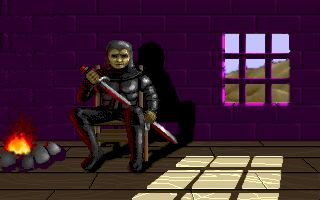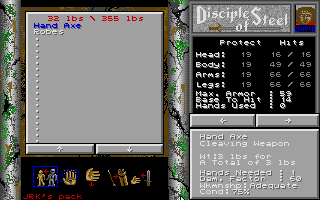Retro Replay Review
Gameplay
Disciples of Steel places you at the head of an eight-member party crafted from the classic Dungeons & Dragons class roster. From stalwart fighters to elusive rogues, each character brings a distinct set of abilities to the table. Character creation itself is rich, allowing you to tailor stats, skills, and equipment from the very start. This depth in party customization rewards thoughtful planning, as synergistic builds can turn the tide of challenging encounters.
(HEY YOU!! We hope you enjoy! We try not to run ads. So basically, this is a very expensive hobby running this site. Please consider joining us for updates, forums, and more. Network w/ us to make some cash or friends while retro gaming, and you can win some free retro games for posting. Okay, carry on 👍)
The core exploration is presented on a simple 2D top-down grid. Your party icon moves square by square, and you’ll encounter everything from wandering monsters to terrain features like forests and towns. Though the “symbolic” art style may feel abstract, it offers clarity. You’ll rarely be confused about where to go or what you’re seeing, and this clean interface helps you focus on strategy rather than deciphering complex visuals.
Combat unfolds on a zoomed-in version of the same grid, transforming exploration into tactical turn-based clashes. Positioning is crucial: high-ground squares or choke points can be exploited, and area-of-effect spells demand careful placement. The rules hew closely to tabletop conventions, so veterans of D&D will feel right at home—but newcomers may face a steep learning curve as they juggle initiative orders, movement allowances, and multiple attack options.
Outside of battles, resource management adds another layer of strategy. Resting to recover spells or hit points costs in-game time and can trigger random encounters. Inventory space is limited, forcing you to decide whether to hoard potion supplies or carry extra equipment. These design choices encourage a dynamic playstyle in which each decision carries weight.
Graphics
Visually, Disciples of Steel opts for a deliberately minimalistic approach. The game world is composed of tiles and icons far removed from modern 3D spectacles. Trees, monsters, and shrines are represented by simple colored symbols, lending the game an almost board-game aesthetic. While this might strike some players as dated, it also ensures that the screen remains uncluttered and that critical information is immediately recognizable.
The zoomed-in combat maps retain the same symbolic flavor, but with larger icons and a few additional visual flourishes. Spell effects are indicated by colored overlays or simple particle animations, making them easy to distinguish without overwhelming the battlefield. It’s not flashy, but it’s functional—and once you learn the iconography, you’ll move through encounters with an almost tactile confidence.
Character portraits appear during dialogue or rest sequences, offering a touch of personality to an otherwise austere presentation. These static images capture each class’s archetype effectively, though they don’t evolve over time. If you’re looking for dynamic sprites or in-engine animations, you won’t find them here—but neither will you be distracted by unnecessary visual noise.
Overall, the graphics serve the gameplay rather than the other way around. The clarity of the UI and map tiles means there’s no ambiguity about your options in combat or exploration. For players who prioritize strategy and role-playing over eye candy, this design philosophy can be a refreshing change of pace.
Story
Disciples of Steel doesn’t unfold through lengthy cutscenes or branching dialogue trees. Instead, the narrative emerges organically as you explore the grid-based world. Townsfolk offer brief hints about bandit sightings, cursed ruins, or hidden treasures. These short vignettes encourage you to chart your own path, unearthing sidequests and mysteries at your own pace.
Despite the absence of an overarching cinematic plot, the game’s lore seeps through environmental details and item descriptions. Ancient altars bear cryptic runes; legendary weapons come with storied histories. If you take the time to inspect each treasure trove or library archive, you’ll piece together a tapestry of conflict between warring factions, demon invasions, and lost civilizations.
Your party’s composition further personalizes the story. A cleric’s moral code can lead to reluctant alliances with certain NPCs, while a necromancer might trigger hostility at the mere sight of dark magic. These class-based interactions don’t branch into full-fledged plot lines, but they do add flavor and replay value, as you’ll notice different reactions and opportunities on subsequent playthroughs.
Ultimately, the story in Disciples of Steel is less about a single epic narrative and more about the journey you carve out. If you’re seeking a game that spoon-feeds you twists and turns, you may feel the lack of a central protagonist arc. But if you prefer to let your decisions and character builds drive emergent storytelling, this title delivers plenty of intrigue.
Overall Experience
Disciples of Steel is a niche gem that caters to players who relish deep character customization and tactical depth. The minimalist presentation may not win awards for visual fidelity, but it keeps the focus squarely on strategic choices, from party composition to battlefield positioning. Every skirmish demands attention, and every dungeon crawl feels earned.
That said, the learning curve can be steep. Newcomers to turn-based RPGs or D&D mechanics may find the early hours daunting, as the interface doesn’t hold your hand. Forums and online guides can help, but part of the appeal is mastering the systems yourself. Patience and perseverance are rewarded with a richly layered experience that few other games attempt in quite the same way.
Performance and stability are generally solid, though occasional pathfinding quirks on the grid can lead to frustrating moments when your characters don’t take the most direct route. Save often, and be prepared to experiment with different tactics if you hit a particularly stubborn encounter.
In conclusion, Disciples of Steel isn’t for everyone—but for adventurers seeking a hardcore RPG that channels the spirit of tabletop gaming, it’s a rewarding journey. Its blend of deep party mechanics, clear visual language, and emergent storytelling makes it a title worth exploring for strategy fans and D&D aficionados alike.
 Retro Replay Retro Replay gaming reviews, news, emulation, geek stuff and more!
Retro Replay Retro Replay gaming reviews, news, emulation, geek stuff and more!









Reviews
There are no reviews yet.